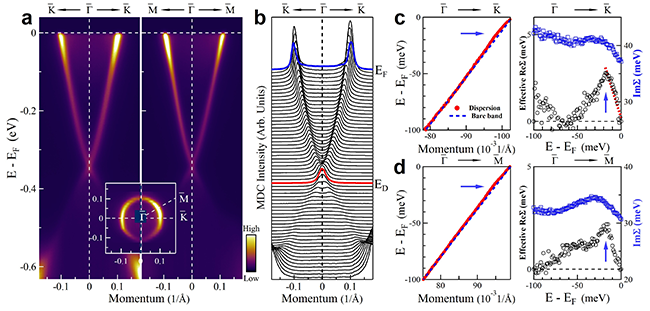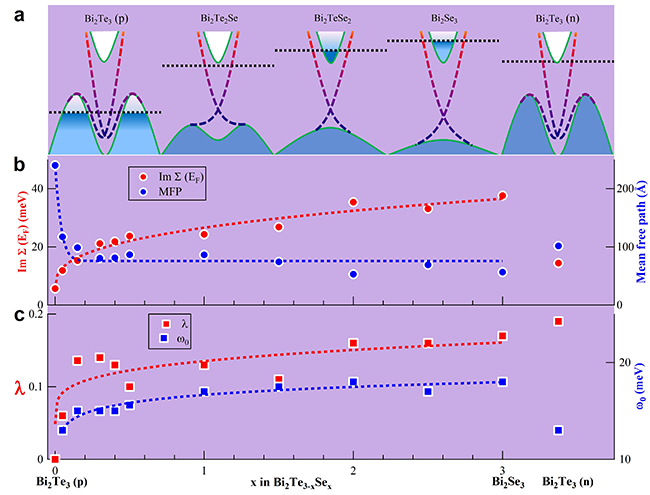Tunable Dirac Fermion Dynamics in Topological Insulators
Date:30-08-2013 Print
Topological insulators represent a new state of matter that has an insulating bulk state but a conducting surface/edge state which hosts an unique spin texture and a linear dispersion relation compatible with massless Dirac fermions. In addition to their potential applications in spintronics and quantum computation, the topological insulators also provide a promising platform for realizing a number of novel and exotic quantum phenomena including quantum spin Hall effects, fractional charge and quantized current, dynamical axion field, magnetic monopole, Majorana fermions, quantum anomalous Hall effects and etc.
Some of these new phenomena have been observed experimentally in two-dimensional topological insulators, such as quantum spin Hall effect and quantum Hall effect in the HgTe quantum wells. However, in the case of three-dimensional topological insulators like the Bi2(Te, Se)3 family, in spite of intensive efforts from transport experiments, attempts to observe electronic transport signatures of the surface Dirac fermions have been hampered by a couple of obstacles. First, contrary to usual expectation that the bulk is insulating in topological insulators, the presence of defects in Bi2(Te, Se)3system makes the bulk conducting and the transport properties are then dominated by the bulk state instead of the desired surface state. Second, in several cases where the surface transport signatures are identified, more than one frequency or one type of charge carriers contribute to the quantum oscillation, indicating the complexity of sample surface exposed to atmosphere or protection layers. In particular, the transport mobility of the surface carriers is not sufficiently high. Although strict electron backscattering is forbidden in topological insulators due to time reversal symmetry invariance, it is important to uncover other scattering channels that limit the transport mobility of the two-dimensional Dirac fermions.
Prof. ZHOU Xingjiang’ group in the National Laboratory of Superconductivity at the Institute of Physics, Chinese Academy of Sciences has performed research on the Dirac fermion dynamics in the prototype topological insulators Bi2(Te, Se)3 family using their Vacuum Ultra-Violet Laser-based Angle-resolved Photoemission Spectroscopy (Laser-ARPES) system with super-high energy and momentum resolutions.
Dr. CHEN Chaoyu and co-workers in Prof. Zhou’ group has grown Bi2(Te3-xSex)single crystals covering a wide range of compositions. They directly revealed, for the first time, the signatures of the electron-phonon coupling from the electron self-energy of the surface Dirac fermions dispersions in Bi2Se3(Fig. 1) and found out that the electron-phonon coupling in p-type Bi2Te3 is nevertheless extremely weak. Furthermore, they have established a phase diagram on the evolution of the Dirac fermion dynamics with composition and the carrier density in the Bi2(Te3-xSex) system (Fig. 2).The Dirac fermion dynamics, specifically the electron-phonon coupling and electron-disorder scattering, can be tuned by controlling the Se composition as well as the carrier density. The electron-disorder scattering plays a dominant role in dictating the dynamics of the Dirac fermions. When compared with Bi2Se3, the p-type Bi2Te3shows weaker electron-phonon coupling and much weaker electron-disorder scattering, which makes it a better choice for studying the transport property of the Dirac fermions.
This work clearly revealed the existence of the electron-phonon coupling in topological insulators and the tunability of the Dirac fermion dynamics. These findings provide crucial information in understanding and engineering the electron dynamics of the Dirac fermions for fundamental studies and potential applications.
The related work is published on Scientific Reports 3, 2411 (2013). It is supported by the National Natural Science Foundation of China (91021006) and the Ministry of Science and Technology of China (973 program 2011CB921703 and 2013CB921700).
CONTACT:
Prof. ZHOU Xingjiang
Institute of Physics, Chinese Academy of Sciences
Email: xjzhou@iphy.ac.cn
 |
| Fig. 1.Observation of the electron-phonon coupling in Bi2Se3.(Image by Prof. ZHOU Xingjiang et al.) |
 |
| Fig. 2.Variation of the electron-phonon coupling and the electron-disorder scattering with composition, x, in Bi2(Te3-xSex) topological insulators. (Image by Prof. ZHOU Xingjiang et al.) |

